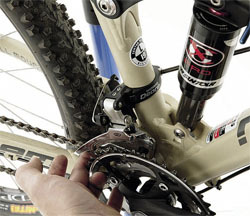 Until someone comes up with another method, we are going to have to stick to cable-actuated chain derailleurs on bikes. Despite the inherent problems with derailing a chain, pushing it sideways so it falls onto adjoining cogs, this is still the most effective and efficient way of changing gear. The basic downfall
Until someone comes up with another method, we are going to have to stick to cable-actuated chain derailleurs on bikes. Despite the inherent problems with derailing a chain, pushing it sideways so it falls onto adjoining cogs, this is still the most effective and efficient way of changing gear. The basic downfall
with indexed gears — the system where a single click equals a single gear ratio change — is that as the cables lose tension over time, gears go out of adjustment and rather than clicking neatly into place they end up as a clunking, slipping, ticking mess that is never in gear or keeps jumping between two. They can also easily get knocked out of alignment.
Random trial-and-error fiddling with barrel adjusters can sometimes stem the minor problems, but it’s always a good idea to get back to basics, and start from scratch with a reset from time to time. It’s also a good time to fit new cables. If the gears are simply out of indexing, touching the limit screw or realigning the front mech’s lateral and height adjustment can be avoided, concentrating purely on the cable tension. But if minor fettlings failed to solve the shifting ailments, then a full check, starting from a known zero, is required.
TOOLS FOR THE JOB:
Cable cutters / Screwdriver (Phillips or flat-bladed — some mechs may even need an Allen key) / Pliers or cable tensioner / Allen keys to suit cable and band clamps.
FRONT MECH:

1 First up, click the shifter to the small chainring and undo the cable clamp bolt.

2 With your fingers check the height of the derailleur. There should be a gap of a couple of millimetres between the chainring and the cage of the mech; leave the mech clamp band Allen bolt merely nipped up.

3 The outer plate of the front derailleur cage should be parallel with the largest chainring. Once you have rotated the mech to the correct position, double check the height and tighten the band clamp.

4 On top of the front derailleur are two screws, marked H and L. These limit screws affect how far the derailleur can move. The L stop limits how close to the seatpost the mech can go. Screw the L limit screw in until there is a 1mm gap between the chain on the small chainring and the inner plate.

5 Before reconnecting the cable, make sure you have enough play in the barrel adjuster at the shifter. It should be two full turns out from fully in.

6 Double check that the shifter is clicked to correspond with the small chainring, and then reconnect the derailleur cable, taking care to seat the cable in any slots. It should be tight but not under undue tension (it’s a lot easier to gauge the tension on subsequent tune-ups).

7 Click to the big chainring while turning the pedals, and click the rear mech to the smallest cog. The inner edge of the outside plate should clear the chain by a millimetre or so. Tension as required. If the mech will not move out far enough, check the H limit screw: you may need to wind it out. If the mech simply won’t go that far due to lack of cable tension, wind out the barrel adjuster (anti-clockwise).

8 With the chain on the middle ring, shift the rear mech to the extremes of the cassette. If the chain rubs the front mech cage, increase or decrease tension as required (outer cage rub — decrease, inner cage rub — increase).
REAR MECH:

1 Click the shifter to the smallest cog, and undo the cable clamp.

2 Like the front mech, the rear has H and L (high and low gear) limit screws. When viewed from behind, the top jockey wheel should be directly below the smallest cog. Tighten the screw if it is to the right, loosen if it’s left.

3 While slowly turning the cranks, push the mech towards the largest cog. If it goes all the way onto the large cog and sits fine, move to stage 4. If it goes over the top, screw the L limit clockwise. If it doesn’t go far enough, screw anticlockwise.

4 Double check your shifter corresponds to the smallest cog. Make sure you have adjustment room on the barrel adjuster, two turns from fully in, and then tension the cable with the pliers. Clamp the cable.

5 Click the shifter one click and the gears should click one cog. If the chain doesn’t go far enough, increase the cable tension by screwing the barrel adjuster out (anti-clockwise), if it goes too far, screw the barrel adjuster in. If the gears are in sync at one end and out at the other, the gear hanger may be bent. On a steel frame this can be straightened. On an alloy frame, a replacement may be needed. Cables full of grit, or simply in need of lube, can also prevent the smooth operation. (see April issue’s Workshop for wash and lube-up details).
TOP TIPS:
Once you’ve set your limit stops, spin the cranks and pump the mech through it’s swing to make sure the chain stays within the cassette’s limits even under force.



